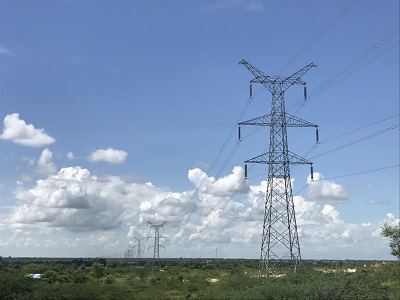
A 230-kilovolt power transmission and transformation project of China Electric Power Equipment and Technology Co., Ltd. The project has become an important part of Myanmar’s power grid. (Photos: People's Daily/Sun Guangyong)
Mandalay (People's Daily) - To realize a nationwide power-up by 2030, the Myanmar government is developing power development programs, including hydropower, gas-fired power, wind power, and solar power generation. As the largest foreign source of Myanmar's power industry, China is cooperating with Myanmar to resolve its power shortage as early as possible. China has conducted all-round cooperation with Myanmar in different fields, including power supply construction, electricity transmission and distribution, technology transfer and training.
Myanmar has rich electric power resources and natural gas reserves; however, its electric power development is falling behind. Only 34 percent of its population has access to electric power. More than 60 percent of the country’s cities, towns and regions cannot be consistently supplied with electricity.
During the two days of interviews in Shwebo, Sagaing Region, Myanmar, reporters saw firsthand the power outages in hotels, restaurants, companies and schools. On the outskirts of Shwebo, hundreds of households face a power shortage. In Mingang’s house, a solar panel supplies power through a thick wire leading to a storage battery next to the window. “When the sun comes out, it will be charged and can be used at night for a while. But a storage battery breaks down after several years, and without a replacement the children only have candles or oil lamps to use while doing their homework,” Mingang said. “When the large transformer substation is completed, there will be electricity.”
Chinese engineering personnel and Myanmar workers at a transformer substation in Shwebo.
The power station is a program carried out in Sagaing by China Electric Power Equipment and Technology Co., Ltd. The program includes constructing two electric transmission lines with a total length of 300 kilometers. A new transformer substation and the expansion of a transformer substation are also included in the program.
The construction site already has concrete columns buried under the ground, with workers from both China and Myanmar.
Many Chinese enterprises participate in the construction of electric power facilities in Myanmar. In Myitkyina, Sagaing, Yangon and Kyaukpyu, workers from both China and Myanmar contribute to the electric power development across the country.
On March 17, the first session of the Sino-Myanmar joint Thaketa natural gas project was finished, which is expected to transmit 720 million kilowatt-hours each year to Myanmar’s power grid.
In Myitkyina, electricity is available during the day. This can be attributed to a hydropower station constructed by a Chinese firm, generating 599 million kilowatt-hours of power each year.
In Myanmar, hydropower is the main source of power, with a proportion of 60.4 percent. The second is natural gas at 35.6 percent. The natural gas pipelines between China and Myanmar have helped Myanmar ease the power pressure and supply the country with quality energy.
Kyaw Win, chairman of the Myanmar Investment Commission, said the commission considers investments in the electric power sector that drives the country’s development as priority projects. He expects Myanmar and China to have more extensive cooperation in electric power and other fields.
Residents in a Shwebo suburb expect more stable power.
(Compiled by Liu Xiaochi)


